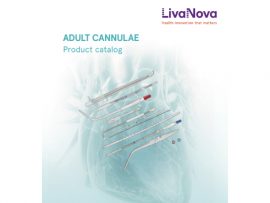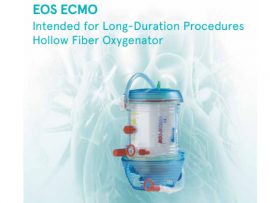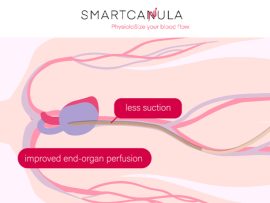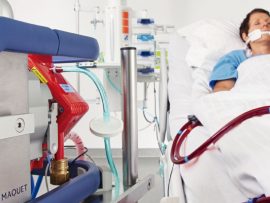Abstract Background Anemia, characterized by low hemoglobin levels, is a global public health concern. Anemia is an independent factor worsening outcomes in various patient groups. Blood transfusion has been the..
Read MoreAbstract Rationale: It is unclear whether extracorporeal CO2 removal (ECCO2R) can reduce the rate of intubation or the total time on invasive mechanical ventilation (IMV) in adults experiencing an exacerbation of chronic..
Read MoreAbstract Artificial intelligence (AI) is a transformative technology with many benefits, but also risks when applied to healthcare and cardiac surgery in particular. Surgeons must be aware of AI and..
Read MoreAbstract Iatrogenic damage to the cardiac conduction system (CCS) remains a significant risk during congenital heart surgery. Current surgical best practice involves using superficial anatomical landmarks to locate and avoid..
Read MoreAbstract Introduction Evidence supports the role of oxygen delivery (DO2) in ameliorating acute kidney injury (AKI). While instrumentation for continuous DO2 measurement exists, a simplified method has been reported for targeting..
Read MoreAbstract Objectives Despite significant improvement in patient blood management, cardiac surgery remains a high hemorrhagic risk procedure. Platelet transfusion is used commonly to treat thrombocytopenia-associated perioperative bleeding. Allogeneic platelet transfusion..
Read MoreAbstract Background In spite of the global implementation of surgical safety checklists to improve patient safety, patients undergoing surgical procedures remain vulnerable to a high risk of potentially preventable complications..
Read MoreAbstract Background: This study aimed to investigate the effects of prone position ventilation treatment on patients with acute respiratory distress syndrome (ARDS) after cardiac surgery. Methods: Clinical data were collected from 93..
Read MoreAbstract Background Healthcare systems are operating under substantial pressures, and often simply cannot provide the standard of care they aspire to within the available resources. Organisations, managers, and individual clinicians..
Read MoreAbstract Background The presence of dextran sulfate (DS) in reagents and the type of blood collection tube (citrate/citrated-theophylline-adenosine-dipyridamole [CTAD]) can lead to discrepancies between unfractionated heparin (UFH) anti-Xa levels. Objectives ..
Read MoreAbstract OBJECTIVES Postoperative delirium (POD) is common, costly and associated with long-term morbidity and increased mortality. We conducted a cohort study to assess the contribution of cardiopulmonary bypass (CPB) to..
Read MoreAbstract Right heart failure (RHF) management after left ventricular assist device (LVAD) implantation includes inotropes, right ventricular mechanical support, and heart transplantation. The purpose of this study is to compare..
Read MoreAbstract Unfractionated heparin, administered during venoarterial extracorporeal membrane oxygenation to prevent thromboembolic events, largely depends on plasma antithrombin for its antithrombotic effects. Decreased heparin responsiveness seems frequent on extracorporeal membrane..
Read MoreAbstract Background: The conventional method of heparin and protamine management during cardiopulmonary bypass (CPB) is based on total body weight which fails to account for the heterogeneous response to heparin in each patient...
Read MoreAbstract In donation after circulatory death (DCD) organ transplantation, normothermic regional perfusion (NRP) restores oxygenated blood flow following cardiac arrest and reverses warm ischemia. Recently, NRP has also been used..
Read MoreAbstract Objective Several machine learning (ML) models have been used in perioperative red blood cell (RBC) transfusion risk for cardiac surgery with limited and no external validation. Hence, we sought to..
Read MoreAbstract It is estimated that many of the complications that occur within the hospital setting are associated with surgical procedures. While some complications, such as sepsis and bleeding, are affected..
Read MoreAbstract Diabetes and hyperglycemic events in cardiac surgical patients are associated with postoperative morbidity and mortality. The causes of , the abnormal fluctuations in concentrations, in the include surgical stress, surgical techniques, medications..
Read MoreAbstract Background Over the past decade, the implementation of simulation education in health care has increased exponentially. Simulation-based education allows learners to practice patient care in a controlled, psychologically safe..
Read More[pdf-embedder url="https://perfusfind.com/wp-content/uploads/2024/05/2024-04-25_smartcanula_Selection-Chart_compressed.pdf" title="2024 04 25_smartcanula_Selection Chart_compressed"]
Read MoreAbstract Introduction Targeted temperature management (TTM) is considered to be a neuroprotective strategy during cardiopulmonary bypass (CPB) assisted procedures, possibly through the activation of cold shock proteins. We therefore investigated..
Read MoreAbstract Extracorporeal membrane oxygenation (ECMO) cannulas inserted through the femoral vein can stray into the ascending lumbar vein. No case has been reported in which the cannula has penetrated the..
Read MoreAbstract We read with great interest Staudacher et al.’s illustra- tive cases of beta-blocker therapy on V-V ECMO [1]. The authors’ excellent work reminds us not to focus on the..
Read MoreAbstract Extracorporeal Membrane Oxygenation (ECMO) is a technology that offers organ support for critically ill patients with respiratory and/or cardiac failure. Despite improvements in recent years in technology and the..
Read MoreAbstract Limb ischaemia is a clinically relevant complication of venoarterial extracorporeal membrane oxygenation (VA ECMO) with femoral artery cannulation. No selective distal perfusion or other advanced techniques were used in..
Read MoreAbstract Introduction Veno-arterial extracorporeal membrane oxygenation (V-A ECMO) improves end-organ perfusion in cardiogenic shock but may increase afterload, which can limit cardiac recovery. Left ventricular (LV) unloading strategies may aid..
Read MoreAbstract Venoarterial extracorporeal membrane oxygenation (VA ECMO) has become a standard of care for severe cardiogenic shock, refractory cardiac arrest and related impending multiorgan failure. The widespread clinical use of..
Read More[pdf-embedder url="https://perfusfind.com/wp-content/uploads/2024/05/2023_smartcanula_Marketing-Broschure-2023-10-30_compressed.pdf" title="2023_smartcanula_Marketing Broschure 2023 10 30_compressed"]
Read MoreAbstract During veno-venous extracorporeal membrane oxygenation (V-V ECMO), blood is drained from the central venous circulation to be oxygenated and decarbonated by an artificial lung. It is then reinfused into..
Read MorePRO Building solid evidence in intensive care medicine is challenging, mostly due to patient heterogeneity and concomitant treatment interactions. In the context of acute respiratory distress syndrome (ARDS), only two..
Read More




















